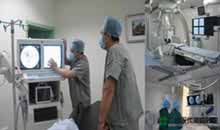- Basic
- Symptoms
- Diagnosis
- Treatments
What is Laryngeal Cancer?
Laryngeal cancer is a malignant cancer that starts in the epithelial tissue of the laryngeal mucosa. The most common laryngeal cancer is laryngeal squamous cell carcinoma.
Incidence of Laryngeal Cancer
The incidence of laryngeal cancer accounts for 1-5% of all cancers of the whole body, it is the third common cancer in ear nose throat department, preceded only by nasopharyngeal cancer and nasal carcinoma or sinus cancer. It often happens to people from 50 to 70 years old, males especially.
Risk Factors of Laryngeal Cancer
(1) Smoking: burning tobacco can produce carcinogens, while its smoke can stop or slow down the ciliary movement and causes mucous hyperemia and edema, resulting in epithelial proliferation and thickening, as well as squamous metaplasia. Thus, carcinogenic basis is established.
(2) Excessive drinking: long-term stimulation to the mucosa can cause degeneration and leads to cancer.
(3)Stimulation from chronic inflammation: such as chronic laryngitis or respiratory inflammation
(4) Air pollution: long-term intake of harmful gas, such as sulfur dioxide and industrial dust, can easily cause laryngeal cancer.
(5) Viral infection: virus can cause cells degeneration and abnormal division or adhere to the gene to be passed to the next generation causing cancers. Infection of HPV16 and HPV18 also has close relation to the incidence of laryngeal cancer.
(6) Precancerous lesion: any recurrence of laryngeal keratosis and benign laryngeal tumors, like laryngeal papilloma, can transform to cancer.
(7) Radioactive rays: treatments using radioactive rays to treat tumors in the neck can cause cancers.
(8) Sex hormone: relevant experiments have proved that the percentage of masculine cells in the estrogen receptor of laryngeal patients is apparently increased.
How Does Laryngeal Cancer Transfer and Diffuse?
1. Directly transfer: advanced laryngeal cancer often infiltrate and transfer to the submucosa.
2. Lymphatic transfusion: laryngeal cancer usually transfers to the superior deep cervical lymphatic nodes in the crotch of common carotid artery, and then goes along the internal jugular vein to invade both the superior and inferior lymph nodes.
3. Transfer through blood vessels: laryngeal cancer can transfer to other body parts, such as lung, liver, kidney, bone and brain through blood circulation
Principles of Postoperative Care of Laryngeal Cancer
(1) After the patient restores their consciousness, help them lie in semi-reclining position to benefit breathing and draining.
(2) Put some ice on the neck to promote the reparation of the wound.
(3) Try to keep unobstructed draining and avoid skin flag necrosis. Observe and note down the characteristics and amount of the draining fluid regularly. Inform the doctor once abnormities occur.
What kinds of supports can be obtained?
Practice proves that the clinic team services composed by multiple disciplines like oncosurgery, oncology, pathology, imageology and anesthesia doctors as well as professional nurses, can provide patients with most effective, most suitable and most economic treatment plan, and also can greatly improve the therapeutic effect of treating cancer patients.
“One station” medical system constructed by Modern Cancer Hospital Guangzhou combining multiple disciplines, can perform comprehensive diagnosis and treatment for patients under the condition of without adding patients’ burden. Therefore, on one hand, it can provide all-round and heartfelt medical services, and on the other hand, it improves medical efficiency and level. There are many channels can be applied to conduct the communication between patients and doctors, like online consultation, email, telephone conversation, and face-to-face consultation. All these consultation services can effectively help patients to fight the cancer. While the medical team faced by the patients includes doctors, nurses, dietitians, interpreters and so on to meet various demands in different level of different countries. Patients would be more confident under the unobstructed communication environment to cooperate the hospital to diagnose and treat the diseases.
In the modern society, laryngeal cancer is seriously threatening people’s health. Due to lack of understanding of laryngeal cancer , patients are often found in late stage. The key to prevent laryngeal cancer is to know about laryngeal cancer symptoms. Here, experts from Modern Cancer Hospital Guangzhou are giving us an introduction of laryngeal cancer symptoms.
According to the location of the cancer, laryngeal cancer can be classified into three types. They are supraglottis laryngeal cancer, which refers to cancer that starts in the area above the vocal cord; glottis laryngeal cancer, which refers to cancer that originates in the vocal cord; and subglottis laryngeal cancer, which starts in the area between the subglottis and inferior border of cricoid cartilage.

Symptoms of laryngeal cancer:
1. Persistent hoarseness, foreign body sensation or swallowing pain in the throat.
The most common symptom of laryngeal cancer is hoarseness. If abnormal hoarseness occurs and persists for more than three weeks without signs of disappearing, one should turn to the ENT specialists for laryngoscopy thoroughly and take treatment timely. As most laryngeal cancers start in the vocal cord, even very small vocal cord tumors can cause abnormal vibration of the vocal cord and result in hoarseness. Foreign body sensation and swallowing pain in the throat are early symptoms of supraglottis laryngeal cancer. Both doctors and patients should not neglect the symptoms even if they are not obvious. Otherwise, diagnosis and treatment will be delayed. Moreover, glottis laryngeal cancer can also cause foreign body sensation and swallowing pain when it reaches mid-late stage.
2. Internal ear pain
When laryngeal cancer develops to certain degrees and causes ulcer and severe inflammation in the throat, it can cause reflective pain of the nerves. Early vocal cord cancer usually does not cause reflective pain that often occurs among patients with mid-late stage supraglottis laryngeal cancer and with appearance of internal ear pain in the same side of the pharyngeal ulcer or inflammation.
3. Have blood in sputum and difficulty in breath
As there are a lot of new blood vessels in the tumor, patients often cough out bloody sputum. This symptom is often caused by supraglottis laryngeal cancer, subglottis laryngeal cancer and mid-late glottis laryngeal cancer. As the tumor severely deteriorates and enlarges in the primary location, it can directly affect breath by obstructing the air tube or causing breath difficulty by obstructing the secretion discharge in the air tube.
Laryngeal cancer is after all a kind of cancer. It is improper to confirm a laryngeal cancer only basing on the symptoms. In fact, examinations are very important in laryngeal cancer diagnosis. Maintaining some knowledge of laryngeal cancer examination is very helpful in correctly diagnosing laryngeal cancer. Here, let’s learn something about the laryngeal cancer diagnosis together.

1. Neck examination: neck examination is one of the laryngeal cancer diagnosis methods. It includes inspection and palpation to the outline of the larynx and the lymph nodes of the neck. Palpation to the lymph nodes of the neck should starts from submandibular region and go down successively to hypohyal, cricothyroid membrane, anterior region of air tube, suprasternal fossa and the anterior and posterior borders of bilateral sternocleidomastoid to figure out the location and size of the swelling lymph nodes, so as to confirm whether there is laryngeal cancer.
2. Laryngoscopy: Indirect laryngoscopy is the most common and simplest examination for laryngeal cancer. However, if one is not satisfied with the result of indirect laryngoscopy or when it is difficult to get the pathology sample, direct laryngoscopy and fibrolaryngoscope can be performed to further study how the inner larynx is invaded by the laryngeal cancer, meanwhile, extract tissues of suspected lesion for pathological examination timely.
3. Imaging examination: it is the most important basis of laryngeal cancer diagnosis
(1) X-ray examination: X-ray lateral projection of the larynx and laminogram of larynx normotopia can clearly reveal the location, size and shape of the laryngeal cancer lesion and the change of the anterior cervical vertebra soft tissues. When necessary, laryngeal radiography can be performed.
(2) CT, MRI examination: CT and MRI are helpful in determining the coverage of laryngeal cancer and its infiltration to areas outside larynx, as well as metastasis to the lymph nodes of the neck. It is especially helpful for advanced laryngeal cancer patients.
(3) Ultrasound tomoscan: it is used to determine the existence and location of the swollen lymph nodes of the neck and its relation with nearby tissues. Moreover, it is also a follow-up examination method after postoperative radiotherapy. Ultrasound tomoscan is harmless, convenient, precise, low outlay and repeatable.
Laryngeal cancer is a common malignant cancer, which has a rapid growth in its incidence. With the increase of smoking among females, there is quite a change in the incidence proportion between male and female. What exactly are the treatment options for laryngeal cancer? Let’s have a look together:

1、 Surgery for laryngeal cancer
For laryngeal cancer, there are many kinds of surgical treatment methods, including hemilaryngectomy, partial laryngectomy , total laryngectomy, and removal of the cervical lymph nodes. These surgical treatments aim at getting long-term effect and function reconstruction. Meanwhile, as people’s understanding of laryngeal cancer develops, these treatment methods are being improved. So far, the major principle of surgical treatment is to completely remove the lesion and hopefully reconstruct the body function, so as to get a better prognosis.
2. Radiation therapy
Combination of radiation therapy with surgery can get a better treatment effect. Doctors can choose to perform radiation therapy either before or after surgery according to the stage and condition of laryngeal cancer.
3. Chemotherapy
Chemotherapy usually is not used as the main treatment for laryngeal cancer. Instead, it is often used in advanced laryngeal cancer as alleviative treatment or assistant treatment before surgery.
4. Chinese medicine
Chinese medicine can be used in comprehensive treatment. It is suitable for those who can’t undergo surgery, chemotherapy and radiotherapy or have recurrence after surgery.
5. Interventional therapy
Interventional therapy is a new treatment method, which has gone through abundant clinical trials and has been proved to be reliable. Interventional therapy for laryngeal cancer is to treat cancer in the manner of blood vessel infusion or embolism. Blood vessel infusion means to infuse the anti-cancer medicine into the cancer in a short and direct manner called intra-arterial infusion, so as to improve local drug concentration and prolong the time of effect, meanwhile, to reduce the damage to nearby tissues. Embolism is to insert solid or liquid medicine into the feeding artery of the cancer to block its supply of blood and nutrient and shrink the tumor, so as to achieve the treatment goal.
Interventional treatment before surgery can shrink the tumor and narrow the surgical range, so as to ensure a successful surgery. For those who cannot undergo surgery, alleviative treatment can be performed to reduce patients’ painfulness and prolong their life.
If you have any questions, please contact us via online consultation, email or phone call. If you find our website useful, please follow our FaceBook and YouTube, health information will be updated regularly.




























